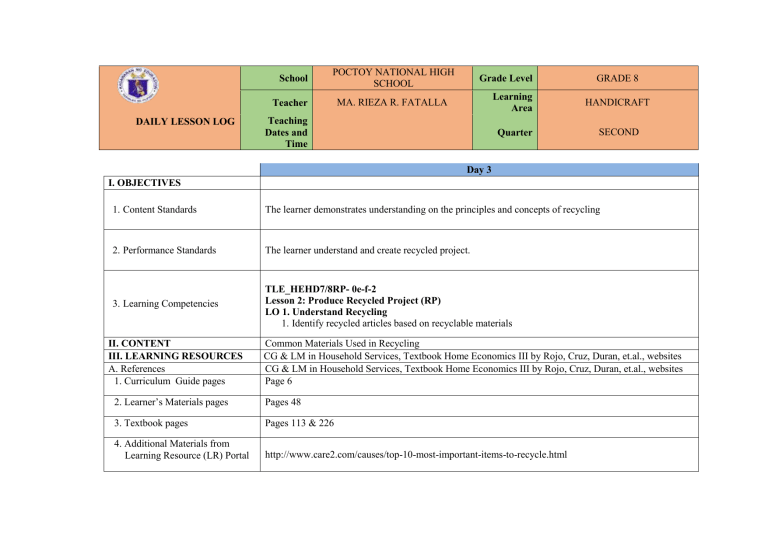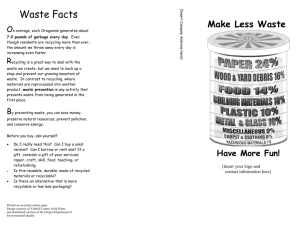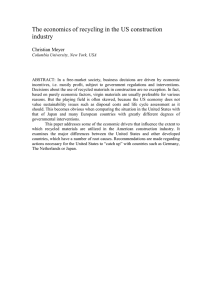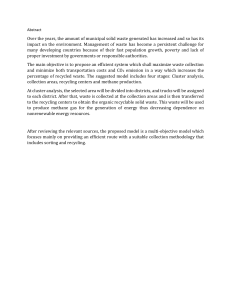
School POCTOY NATIONAL HIGH SCHOOL Teacher DAILY LESSON LOG Grade Level MA. RIEZA R. FATALLA Teaching Dates and Time GRADE 8 Learning Area HANDICRAFT Quarter SECOND Day 3 I. OBJECTIVES 1. Content Standards The learner demonstrates understanding on the principles and concepts of recycling 2. Performance Standards The learner understand and create recycled project. 3. Learning Competencies TLE_HEHD7/8RP- 0e-f-2 Lesson 2: Produce Recycled Project (RP) LO 1. Understand Recycling 1. Identify recycled articles based on recyclable materials II. CONTENT III. LEARNING RESOURCES A. References 1. Curriculum Guide pages Common Materials Used in Recycling CG & LM in Household Services, Textbook Home Economics III by Rojo, Cruz, Duran, et.al., websites CG & LM in Household Services, Textbook Home Economics III by Rojo, Cruz, Duran, et.al., websites Page 6 2. Learner’s Materials pages Pages 48 3. Textbook pages Pages 113 & 226 4. Additional Materials from Learning Resource (LR) Portal http://www.care2.com/causes/top-10-most-important-items-to-recycle.html B. Other Learning Resources IV. PROCEDURE “Write and Post” A. Reviewing previous lesson/presenting the new lesson Distribute metacards to the students. Let them write some advantages of recycling and post it on the board. Analyze and check students’ output. “Let’s Segregate” - Let the students place the garbage/trashes they have brought in the corresponding bin. B. Establishing a purpose for the lesson - Ask the students to select from each bin those trashes that can be recycled. “Care and Stare” - Show some examples (realia) of recycled articles and ask the students to identify each. C. Presenting examples/ instances of the new lesson From what material does each article made of? Ask: D. Discussing new concepts and practicing new skills # 1 “Trash List” - Let the students group themselves and make a list of the recyclable in their respective areas. - Ask a member of each group to according to their locality. Let them think waste materials that are commonly found present their work. Team Thinking E. Discussing new concepts and practicing new skills # 2 - Using the list of waste materials, each group will have a brainstorming about the possible articles that can be made out of those materials. - Let a member of each group present their output in the class. Name five (5) examples of recyclable materials and give two (2) articles that can be made out of each material. Recyclable Materials A. B. F. Developing mastery C. D. E. G. Finding practical applications of concepts and skills in daily living Articles 1. 2. 3. 4 5. 6 7. 8. 9. 10 Your sibling was assigned by her teacher to make a recycled plant pot. What materials can you use in order to accomplish the task? Ask students to fill in this flow chart H. Making generalizations abstractions about the lesson and I. Evaluating learning Directions: List down the articles that can be possibly made out of the following recyclable materials. Materials Articles Glass bottles 1. 2. Paper 3. 4. Plastic containers 5. 6. Tin cans 7. 8. Yarn wastes 9 10 J. Additional activities for application or remediation Look around your home. Take note of the things that are normally thrown away or disposed after they have been used for their original purpose. Think of the articles into which an item can be converted or recycled. V. REMARKS VI. REFLECTION A. No. of learners who earned 80% in the evaluation B. No. of learners who require additional activities for remediation who scored below 80% C. Did the remedial lessons work? No. of learners who have caught up with the lesson. D. No. of learners who continue to require remediation E. Which of my teaching strategies worked well? Why did these work? F. What difficulties did I encounter which my principal or supervisor can help me solve? G. What innovation or localized materials did I use/discover which I wish to share with other teachers? Prepared by: MA. RIEZA R. FATALLA Subject Teacher Inspected/Noted: CHERRY ANN F. DEL MUNDO, Ed. D. School Head



